高中英语试卷评讲课教学设计
- 格式:doc
- 大小:38.00 KB
- 文档页数:4
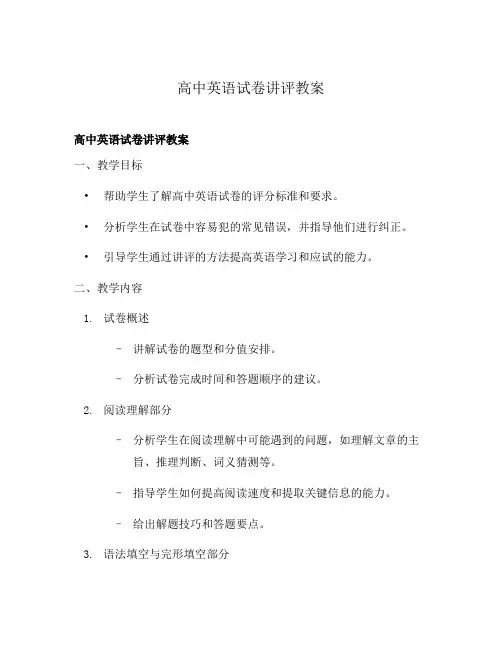
高中英语试卷讲评教案高中英语试卷讲评教案一、教学目标•帮助学生了解高中英语试卷的评分标准和要求。
•分析学生在试卷中容易犯的常见错误,并指导他们进行纠正。
•引导学生通过讲评的方法提高英语学习和应试的能力。
二、教学内容1.试卷概述–讲解试卷的题型和分值安排。
–分析试卷完成时间和答题顺序的建议。
2.阅读理解部分–分析学生在阅读理解中可能遇到的问题,如理解文章的主旨、推理判断、词义猜测等。
–指导学生如何提高阅读速度和提取关键信息的能力。
–给出解题技巧和答题要点。
3.语法填空与完形填空部分–指导学生掌握常见的语法知识和词汇用法。
–分析学生容易犯的常见错误,如动词时态、主谓一致、词形变化等。
–引导学生通过语境判断、选项排除等方法解题。
4.短文改错部分–分析学生在短文改错中容易犯的错误类型,如语法错误、拼写错误、词汇用法错误等。
–提醒学生注意标点符号、大小写、时态等方面的错误。
–解释评分标准和扣分要点。
5.书面表达部分–分析学生在书面表达中可能存在的问题,如句子结构、用词准确性、逻辑连贯性等。
–给出写作技巧和范文参考,指导学生如何提高写作水平。
–讲解评分标准和常见的扣分项。
三、教学方法•讲解分析法:通过解析试卷题目的设计和解题思路,引导学生理解题意和解题技巧。
•互动提问法:通过提问学生容易出错的地方,帮助他们准确理解知识点和答题要求。
•案例分析法:选取一些学生的试卷进行分析和评讲,让学生从错误中学习和充分认识标准答案的要求。
四、教学步骤1.介绍教学目标和教学内容。
2.带领学生回顾试卷的题型和分值安排。
3.以阅读理解部分为例,进行示范讲解,引导学生理解解题思路和答题要求。
4.分组活动:学生分组讨论并分析其他题型中的常见错误和解题技巧。
5.案例分析:随机选取几份试卷进行评讲,引导学生理解评分标准和答题要点。
6.解答学生的疑问,针对性提出改进建议和学习方法。
7.总结教学要点和方法,鼓励学生通过反思总结来提高应试能力。
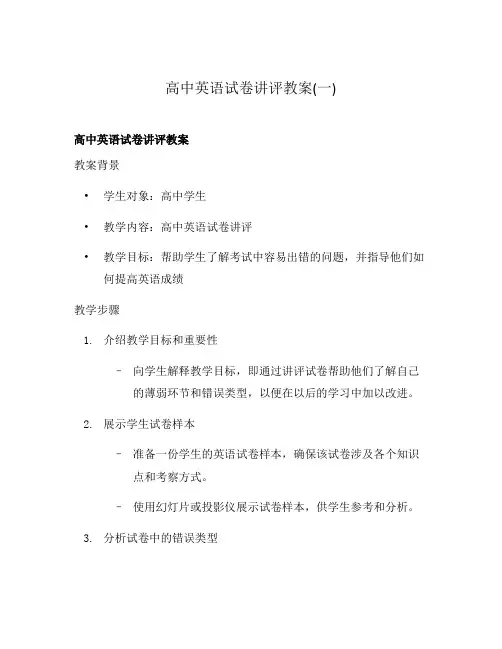
高中英语试卷讲评教案(一)高中英语试卷讲评教案教案背景•学生对象:高中学生•教学内容:高中英语试卷讲评•教学目标:帮助学生了解考试中容易出错的问题,并指导他们如何提高英语成绩教学步骤1.介绍教学目标和重要性–向学生解释教学目标,即通过讲评试卷帮助他们了解自己的薄弱环节和错误类型,以便在以后的学习中加以改进。
2.展示学生试卷样本–准备一份学生的英语试卷样本,确保该试卷涉及各个知识点和考察方式。
–使用幻灯片或投影仪展示试卷样本,供学生参考和分析。
3.分析试卷中的错误类型–按照试卷的顺序,列出学生常犯的错误类型。
例如,语法错误、拼写错误、翻译错误等。
–解释每种错误类型的特点,并提供示例以帮助学生理解错误的原因。
4.解释容易出错的题目–选取试卷中较为困难或容易出错的题目,逐一解释答案和解题思路。
–强调常见的误解和陷阱,并指导学生如何避免类似错误。
5.探讨提高英语成绩的方法–和学生一起讨论提高英语成绩的方法和技巧,如多做练习、积累词汇、注意语法和句型结构等。
–提醒学生制定学习计划并保持良好的学习习惯。
6.练习巩固–安排一些与试卷中相似的练习题,供学生随堂练习,以检验他们对讲评内容的理解和掌握情况。
教学效果评价•通过学生的参与和练习情况来评价教学效果。
•考察学生对讲评内容的理解和应用能力。
•了解学生对英语学习的态度和改进措施。
参考资料•教科书和教学参考资料中关于试卷讲评的相关内容高中英语试卷讲评教案(续)教学步骤(续)7.分组讨论和分享–将学生分成小组,让他们讨论并分享在试卷中容易出错的问题和解题困惑。
–鼓励学生在小组中互相解答问题和比较答案,促进彼此的学习和帮助。
8.提供解决问题的策略–在讨论和分享的过程中,引导学生提供解决问题的策略和技巧。
–提供一些建议,例如如何读懂题目、如何分析选项、如何有条理地写作等。
9.演示范例–选择一些典型的试题或写作题目,向学生演示如何正确解答。
–解释思考过程、技巧和方法,帮助学生理解和运用。
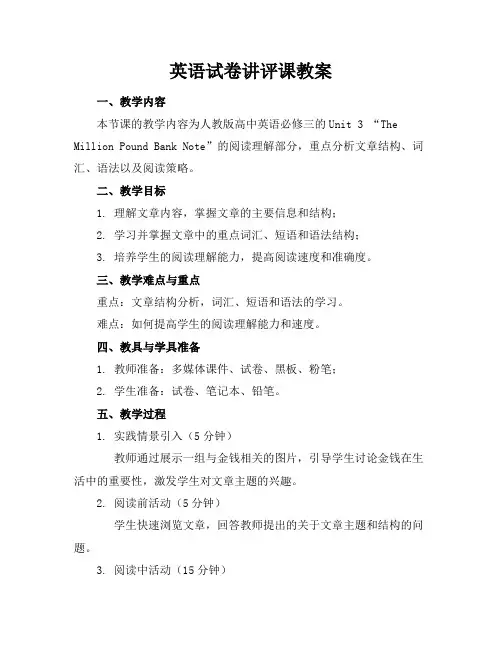
英语试卷讲评课教案一、教学内容本节课的教学内容为人教版高中英语必修三的Unit 3 “The Million Pound Bank Note”的阅读理解部分,重点分析文章结构、词汇、语法以及阅读策略。
二、教学目标1. 理解文章内容,掌握文章的主要信息和结构;2. 学习并掌握文章中的重点词汇、短语和语法结构;3. 培养学生的阅读理解能力,提高阅读速度和准确度。
三、教学难点与重点重点:文章结构分析,词汇、短语和语法的学习。
难点:如何提高学生的阅读理解能力和速度。
四、教具与学具准备1. 教师准备:多媒体课件、试卷、黑板、粉笔;2. 学生准备:试卷、笔记本、铅笔。
五、教学过程1. 实践情景引入(5分钟)教师通过展示一组与金钱相关的图片,引导学生讨论金钱在生活中的重要性,激发学生对文章主题的兴趣。
2. 阅读前活动(5分钟)学生快速浏览文章,回答教师提出的关于文章主题和结构的问题。
3. 阅读中活动(15分钟)学生精读文章,分析文章结构,学习词汇和语法。
教师讲解重点知识点,解答学生的疑问。
4. 例题讲解(10分钟)教师选取一篇类似的阅读理解文章,为学生讲解解题技巧,并进行示范解题。
5. 随堂练习(10分钟)学生独立完成一篇阅读理解练习,巩固所学知识。
6. 小组讨论(5分钟)学生分小组讨论阅读理解中的难题,分享解题心得。
六、板书设计1. 文章结构图;2. 重点词汇、短语和语法;3. 解题技巧。
七、作业设计1. 作业题目:完成一篇阅读理解练习;答案:见附件。
八、课后反思及拓展延伸1. 反思:教师针对本节课的教学效果进行自我反思,调整教学方法;2. 拓展延伸:推荐学生阅读与金钱相关的英文文章,提高阅读水平。
重点和难点解析1. 教学目标的设定;2. 教学难点与重点的确定;3. 教学过程中的实践情景引入、例题讲解和随堂练习;4. 板书设计;5. 作业设计;6. 课后反思及拓展延伸。
一、教学目标的设定1. 确保目标与教学内容紧密结合;2. 明确学生应掌握的知识和技能;3. 注重培养学生的实际运用能力。

高中英语月考卷讲评教案
一、试卷结构分析
本次月考试卷分为四个部分:听力、单项选择、完形填空和阅读理解。
各部分分值比例分
别为:听力20%,单项选择30%,完形填空20%,阅读理解30%。
整体来看,试卷难度
适中,涵盖了高中英语课程的主要知识点,有利于全面考察学生的英语水平。
二、听力部分
听力部分共有四个小题,包括对话、短文和信息匹配等题型。
在讲评时,教师应重点讲解
听力材料的主旨大意,引导学生注意捕捉关键信息。
同时,教师可以结合具体题目,教授
一些解题技巧,如预测答案、关注转折词等。
三、单项选择部分
单项选择部分共有20个小题,涉及词汇、语法、句型等多个方面。
在讲评时,教师应针
对每个小题进行详细解析,帮助学生理解题目要求,掌握解题方法。
教师还可以结合错题,进行针对性的讲解,帮助学生巩固基础知识。
四、完形填空部分
完形填空部分共有15个空,要求学生在阅读短文的基础上,选择合适的词语填空。
在讲
评时,教师应引导学生关注文章的逻辑关系和上下文线索,培养学生的语篇意识。
同时,
教师可以结合具体题目,讲解一些常见的搭配和用法,提高学生的词汇运用能力。
五、阅读理解部分
阅读理解部分共有四篇文章,每篇文章后面有五个问题。
在讲评时,教师应重点讲解文章
的主旨大意和作者的观点态度,引导学生学会快速捕捉信息。
教师还可以结合具体题目,
教授一些解题技巧,如定位关键词、排除干扰项等。
六、总结与反思。
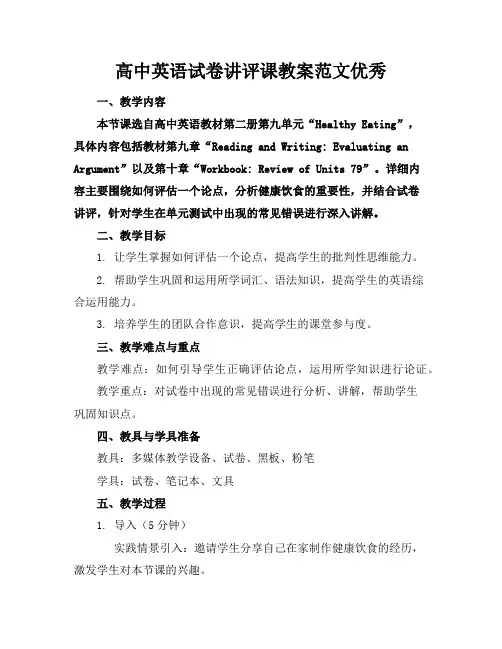
高中英语试卷讲评课教案范文优秀一、教学内容本节课选自高中英语教材第二册第九单元“Healthy Eating”,具体内容包括教材第九章“Reading and Writing: Evaluating an Argument”以及第十章“Workbook: Review of Units 79”。
详细内容主要围绕如何评估一个论点,分析健康饮食的重要性,并结合试卷讲评,针对学生在单元测试中出现的常见错误进行深入讲解。
二、教学目标1. 让学生掌握如何评估一个论点,提高学生的批判性思维能力。
2. 帮助学生巩固和运用所学词汇、语法知识,提高学生的英语综合运用能力。
3. 培养学生的团队合作意识,提高学生的课堂参与度。
三、教学难点与重点教学难点:如何引导学生正确评估论点,运用所学知识进行论证。
教学重点:对试卷中出现的常见错误进行分析、讲解,帮助学生巩固知识点。
四、教具与学具准备教具:多媒体教学设备、试卷、黑板、粉笔学具:试卷、笔记本、文具五、教学过程1. 导入(5分钟)实践情景引入:邀请学生分享自己在家制作健康饮食的经历,激发学生对本节课的兴趣。
2. 试卷讲评(15分钟)(2)针对试卷中的重点、难点进行详细讲解,帮助学生纠正错误。
3. 例题讲解(15分钟)(1)选取具有代表性的例题进行讲解,引导学生正确评估论点。
(2)结合教材内容,讲解相关词汇、语法知识。
4. 随堂练习(10分钟)(1)布置相关练习题,巩固所学知识。
(2)邀请学生上台展示,鼓励学生积极参与。
5. 小组讨论(10分钟)(1)将学生分成小组,针对某一健康饮食话题进行讨论。
(2)引导学生运用所学知识进行论证,提高学生的批判性思维能力。
六、板书设计1. 试卷讲评部分:列出重点、难点,标注易错点。
3. 随堂练习部分:列出练习题目,展示答案。
七、作业设计1. 作业题目:(1)完成Workbook中的Review of Units 79练习。
(2)针对某一健康饮食话题,写一篇小论文,评估论点并给出自己的观点。

【教案】高中英语试卷讲评教案一、教学目标:1. 帮助学生理解试卷中的知识点,巩固所学知识。
2. 提高学生分析问题、解决问题的能力。
3. 培养学生的批判性思维和团队合作精神。
二、教学内容:1. 试卷分析:对试卷的整体难度、题型、分值等进行分析,让学生了解试卷的构成。
2. 错误分析:针对学生普遍存在的问题进行分类整理,找出错误的原因。
3. 知识点讲解:针对试卷中的重点、难点进行讲解,巩固学生的基础知识。
4. 解题技巧分享:分享解题技巧,帮助学生提高答题速度和准确性。
三、教学过程:1. 课前准备:教师提前准备好试卷分析报告,了解学生的答题情况。
2. 课堂导入:简要介绍试卷分析报告,激发学生的学习兴趣。
3. 试卷分析:教师引导学生对试卷进行分析,让学生了解试卷的难度和题型。
4. 错误分析:教师引导学生找出自己的错误,分析错误的原因。
5. 知识点讲解:针对学生的错误和疑问,教师进行详细讲解。
6. 解题技巧分享:教师分享解题技巧,引导学生进行讨论。
7. 课堂练习:学生进行课堂练习,巩固所学知识。
四、教学评价:1. 学生课堂参与度:观察学生在课堂上的发言和讨论情况,了解学生的学习积极性。
2. 学生练习成果:检查学生的课堂练习,评估学生的学习效果。
3. 学生反馈:收集学生的反馈意见,了解学生的学习需求。
五、教学资源:1. 试卷分析报告:教师自备。
2. 教学PPT:教师根据教学内容制作。
3. 课堂练习题:教师根据知识点设计。
4. 参考资料:教师提供相关参考资料,帮助学生巩固知识。
六、教学策略:1. 案例分析:通过具体案例,让学生了解试卷中的实际应用。
2. 小组讨论:引导学生进行小组讨论,培养学生的团队合作精神。
3. 互动提问:教师提问,学生回答,激发学生的思维活跃度。
4. 任务驱动:布置相关任务,让学生在实践中运用所学知识。
七、教学注意事项:1. 关注学生的个体差异,因材施教。
2. 鼓励学生提问,充分调动学生的积极性。
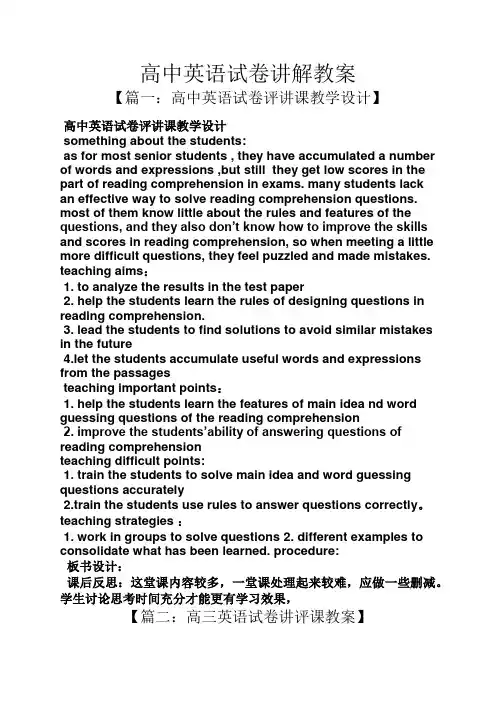
高中英语试卷讲解教案【篇一:高中英语试卷评讲课教学设计】高中英语试卷评讲课教学设计something about the students:as for most senior students , they have accumulated a number of words and expressions ,but still they get low scores in the part of reading comprehension in exams. many students lackan effective way to solve reading comprehension questions. most of them know little about the rules and features of the questions, and they also don’t know how to improve the skills and scores in reading comprehension, so when meeting a little more difficult questions, they feel puzzled and made mistakes. teaching aims:1. to analyze the results in the test paper2. help the students learn the rules of designing questions in reading comprehension.3. lead the students to find solutions to avoid similar mistakes in the future4.let the students accumulate useful words and expressions from the passagesteaching important points:1. help the students learn the features of main idea nd word guessing questions of the reading comprehension2. improve the students’ability of answering questions of reading comprehensionteaching difficult points:1. train the students to solve main idea and word guessing questions accurately2.train the students use rules to answer questions correctly。
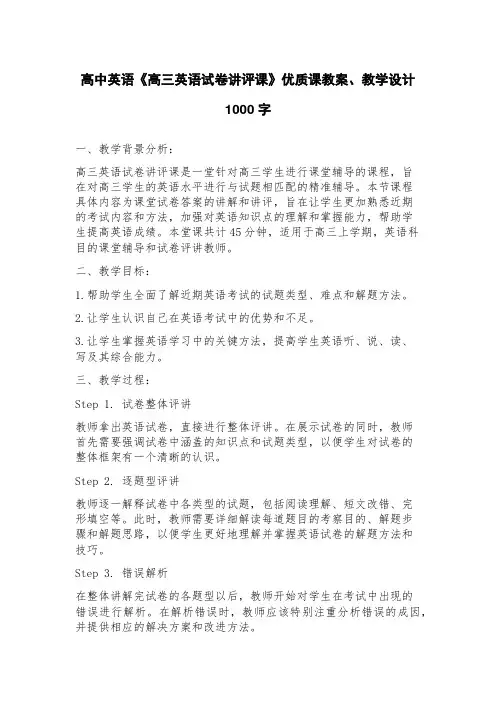
高中英语《高三英语试卷讲评课》优质课教案、教学设计1000字一、教学背景分析:高三英语试卷讲评课是一堂针对高三学生进行课堂辅导的课程,旨在对高三学生的英语水平进行与试题相匹配的精准辅导。
本节课程具体内容为课堂试卷答案的讲解和讲评,旨在让学生更加熟悉近期的考试内容和方法,加强对英语知识点的理解和掌握能力,帮助学生提高英语成绩。
本堂课共计45分钟,适用于高三上学期,英语科目的课堂辅导和试卷评讲教师。
二、教学目标:1.帮助学生全面了解近期英语考试的试题类型、难点和解题方法。
2.让学生认识自己在英语考试中的优势和不足。
3.让学生掌握英语学习中的关键方法,提高学生英语听、说、读、写及其综合能力。
三、教学过程:Step 1. 试卷整体评讲教师拿出英语试卷,直接进行整体评讲。
在展示试卷的同时,教师首先需要强调试卷中涵盖的知识点和试题类型,以便学生对试卷的整体框架有一个清晰的认识。
Step 2. 逐题型评讲教师逐一解释试卷中各类型的试题,包括阅读理解、短文改错、完形填空等。
此时,教师需要详细解读每道题目的考察目的、解题步骤和解题思路,以便学生更好地理解并掌握英语试卷的解题方法和技巧。
Step 3. 错误解析在整体讲解完试卷的各题型以后,教师开始对学生在考试中出现的错误进行解析。
在解析错误时,教师应该特别注重分析错误的成因,并提供相应的解决方案和改进方法。
Step 4. 学生讨论在评讲过后,教师应该充分利用课堂时间,让学生提出自己对试卷的疑惑、问题和建议,并与整个班级进行讨论和交流。
在学生讨论过后,可以让学生自主进行一些英语试题的练习,以检验学生的英语水平和掌握情况。
四、教学方法:1.讲解法:通过课堂试卷的解析进行教学。
2.研讨法:让学生在课堂上互相讨论,加深对英语知识点的理解。
3.引导法:通过教师的引导,让学生自主探究解决问题的方法。
五、教学评价:本节课程的评价主要从以下三个方面进行:1.学生对本节课程的反映和反馈:通过听取学生的反馈和意见,评估本节课程的效果和授课质量。
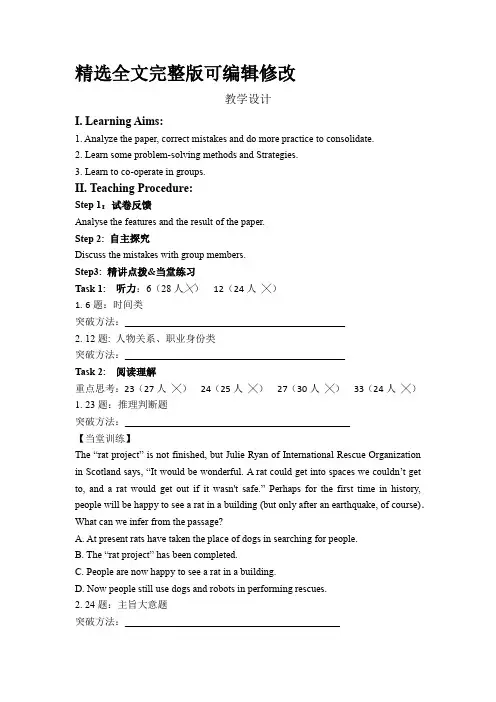
精选全文完整版可编辑修改教学设计I. Learning Aims:1. Analyze the paper, correct mistakes and do more practice to consolidate.2. Learn some problem-solving methods and Strategies.3. Learn to co-operate in groups.II. Teaching Procedure:Step 1:试卷反馈Analyse the features and the result of the paper.Step 2: 自主探究Discuss the mistakes with group members.Step3: 精讲点拨&当堂练习Task 1: 听力:6(28人╳)12(24人╳)1.6题:时间类突破方法:____________________________________________2.12题: 人物关系、职业身份类突破方法:____________________________________________Task 2: 阅读理解重点思考:23(27人╳)24(25人╳)27(30人╳)33(24人╳)1.23题:推理判断题突破方法:_____________________________________________【当堂训练】The “rat project” is not finished, but Julie Ryan of International Rescue Organization in Scotland says, “It would be wonderful. A rat could get into spaces we couldn’t get to, and a rat would get out if it wasn't safe.” Perhaps for the first time in history, people will be happy to see a rat in a building (but only after an earthquake, of course).What can we infer from the passage?A. At present rats have taken the place of dogs in searching for people.B. The “rat project” has been completed.C. People are now happy to see a rat in a building.D. Now people still use dogs and robots in performing rescues.2. 24题:主旨大意题突破方法:___________________________________________【当堂训练】Every year Chris Brogan posts his three words for a new year. Many others and I have followed his lead for the past three or four years. They helped me a lot. My words for last year were "passion", "focus" and "delegate" and I stayed true to them. This year, 2018, my goals are more personal and less professional.The best title for the passage might be________?A. Three Words for 2018B. Health Should Go FirstC. Keep OrganizedD. My Goals3. 27题:细节理解题突破方法:_________________________________________________________【当堂训练】Having friends may well keep you healthier and help you deal with stress better. Some studies show that people with close friends have a greater ability to fight disease than people who are alone.People who are alone have a ability to fight disease than people with close friends.A. moreB. greaterC. poorerD. little4. 33题:词义猜测题突破方法:________________________________________________________【当堂训练】Focus is making a repeat appearance on my list this year because I'm too much of a multitasker. The problem is that I have trouble finishing one thing with so many things calling me. When I was working as a writer, all my projects were handled via a schedule, which kept me organized. This year I'm going to have each task scheduled. I'm putting a fitness and housekeeping routine into my schedule.The underlined word "multitasker" probably refers to a person who________.A. makes a living by writingB. always fails to finish a task on timeC. has several things to do at the same timeD. pays more attention to fitness and housekeepingTask 3. 完形填空重点思考:42(24人╳)45(29人╳)46(26人╳)51(21人╳)55(23人╳)56(30人╳)59(23人╳)语言考点:_______________________________________________高分技巧:_______________________________________________Task 4. 语法填空重点思考:62(33人╳)63(26人╳)64(23人╳)62.定语从句中that和which的区别1)只能用that而不能用which的情形:_____________________________________________________________________ _____________________________________________________________________ 2)只能用which而不能用that的情形_____________________________________________________________________ _____________________________________________________________________【当堂训练】1)There is nothing will stop us making progress.2)The pencil-case, I bought last week, is missing.3)Luxun and his works we are familiar with are considered great.4) The tree under we used to take a rest has been cut down.63. 动词变名词(+ion)_____________________________________________________________________ Task 5. 书面表达Attention:1.四大名著西游记Journey to the West红楼梦A Dream in Red Mansions (The Story of the Stone)水浒传Water Margin三国演义Romance of the Three Kingdoms2.语法错误(grammatical error)1)主谓不一致(subject and verb disagreement)He always protect his teacher... \ The book tell us2) 句子结构不完整(incomplete sentence structure)The story's origin in ancient times.3.句型单一,多用短句且衔接不当The book author Si Maqian is our learned people. He is strong and brave.4.书写(handwriting)Step 4. 巩固练习1.Most people know the feeling when you walk into a lift (电梯) with other people.A study has found that where people stand is based on their social position on entering the liftRebekah Rousi, a Ph.D. student, did a study of lift behavior in two of the tallest office buildings in Adelaide, Australia. As part of her research, she took a total of 30 lift rides in the two buildings, and discovered there was a fixed order about where people chose to stand.In her research paper, she wrote that more senior men seemed to walk straight towards the back of the lift. She said, “In front of them were younger men, and in front of them were women of all ages.” She also noticed there was a difference in the direction where people look during the ride. “Men watched the monitors, looked in the side mirrors (in one building) to see themselves, and in the door mirrors (in the other building) to watch others. Women would watch the monitors and avoid looking into others’ eyes (unless in conversations) and the mirrors.”Rebekah Rousi concluded that shyer people stand toward the front, where they can’t see other passengers, while fearless people stand in the back, where they have a good view of everyone else.1)According to the study, where people stand in a lift is decided by __________. A. their social position B. the monitorsC. other passengersD. others’ position2)Who are most likely to go to the back of the lift?A. Shyer people.B. Senior men.C. Younger men.D. Women.3)Which is true according to the passage?A. The order in which people stand in a lift is fixed.B. Few people feel embarrassed with strangers in a lift.C. Women like watching themselves in the side mirrors.D. Fearless people stand in the back to avoid seeing others.4)The passage is probably taken from________A. a lift instructionB. a story bookC. a travel guideD. a newspaper2. The way we cook is important. In many countries, the two choices are (nature) gas or electric-powered stoves.The World Health Organization warns that millions of people (suffer) fromindoor air pollution at present time, which results from the use of (danger) fuels and cook-stoves in the home.WHO officials say nearly three billion people are (able) to use clean fuels and technologies for cooking ,heating and lighting. As a result, more than seven million people die from exposure to indoor or outdoor air pollution each year. Most of the deaths are in (develop)countries, such as lndia, China and Latin American countries.WHO officials say opening a window or door (let)out the harmful air will not correct the situation.will only pollute the outdoors.Nigel Bruce, is a professor of Public Health at the University of Liverpool, says researchers are developing good cook-stoves and other equipment to burn fuels a more efficient way.But, this is just a start. It is urging developing countries to use (clean) fuels and increase access to cleaner and more modern cooking and heating appliances(用具).Step5. Homework1.Memorize the language points we analyzed in class.2.Modify your essay according to the analyses in class.学情分析学习能力:高二学生经过一年半的学习,具备了一定的知识储备:词汇、短语及句型储备丰富,熟悉高考常考高频语法知识,并且也有了一定的阅读理解和语言表达能力。
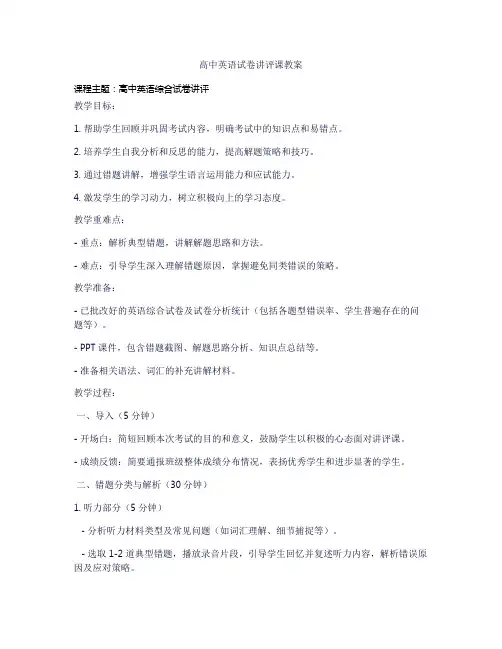
高中英语试卷讲评课教案课程主题:高中英语综合试卷讲评教学目标:1. 帮助学生回顾并巩固考试内容,明确考试中的知识点和易错点。
2. 培养学生自我分析和反思的能力,提高解题策略和技巧。
3. 通过错题讲解,增强学生语言运用能力和应试能力。
4. 激发学生的学习动力,树立积极向上的学习态度。
教学重难点:- 重点:解析典型错题,讲解解题思路和方法。
- 难点:引导学生深入理解错题原因,掌握避免同类错误的策略。
教学准备:- 已批改好的英语综合试卷及试卷分析统计(包括各题型错误率、学生普遍存在的问题等)。
- PPT课件,包含错题截图、解题思路分析、知识点总结等。
- 准备相关语法、词汇的补充讲解材料。
教学过程:一、导入(5分钟)- 开场白:简短回顾本次考试的目的和意义,鼓励学生以积极的心态面对讲评课。
- 成绩反馈:简要通报班级整体成绩分布情况,表扬优秀学生和进步显著的学生。
二、错题分类与解析(30分钟)1. 听力部分(5分钟)- 分析听力材料类型及常见问题(如词汇理解、细节捕捉等)。
- 选取1-2道典型错题,播放录音片段,引导学生回忆并复述听力内容,解析错误原因及应对策略。
2. 单项选择/完形填空(10分钟)- 根据错误率最高的题型展开,分析常考语法点、词汇辨析。
- 通过PPT展示错题,引导学生讨论并解释正确答案的理由,教师补充讲解易混淆知识点。
3. 阅读理解(10分钟)- 概述阅读理解常见题型(主旨大意、细节理解、推理判断等)。
- 选取一两篇错误率较高的文章,分析解题思路和技巧,强调信息筛选和逻辑推理的重要性。
4. 书面表达(5分钟)- 分析作文普遍存在的问题(如结构不清晰、语法错误、词汇匮乏等)。
- 展示一篇范文或典型错误作文,通过对比讲解,指出优点和不足,强调写作技巧和表达能力的提升方法。
三、知识巩固与拓展(15分钟)- 错题回顾:要求学生重新思考自己的错题,并尝试口头解答或写在练习本上。
- 知识点总结:根据本次考试暴露的问题,系统总结相关语法点、词汇用法和解题技巧。
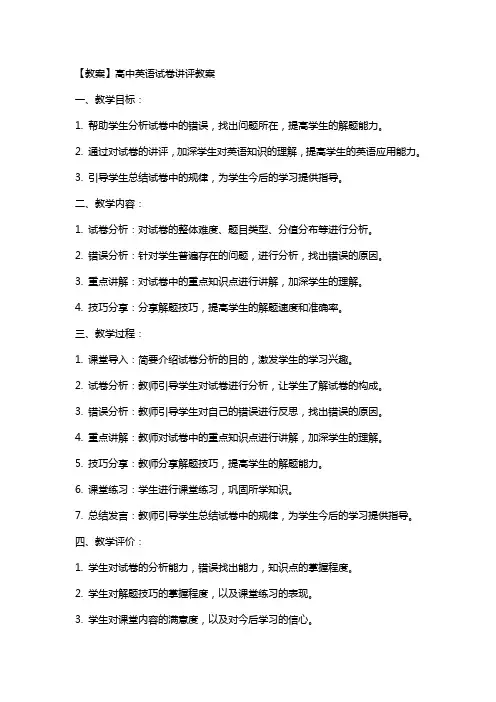
【教案】高中英语试卷讲评教案一、教学目标:1. 帮助学生分析试卷中的错误,找出问题所在,提高学生的解题能力。
2. 通过对试卷的讲评,加深学生对英语知识的理解,提高学生的英语应用能力。
3. 引导学生总结试卷中的规律,为学生今后的学习提供指导。
二、教学内容:1. 试卷分析:对试卷的整体难度、题目类型、分值分布等进行分析。
2. 错误分析:针对学生普遍存在的问题,进行分析,找出错误的原因。
3. 重点讲解:对试卷中的重点知识点进行讲解,加深学生的理解。
4. 技巧分享:分享解题技巧,提高学生的解题速度和准确率。
三、教学过程:1. 课堂导入:简要介绍试卷分析的目的,激发学生的学习兴趣。
2. 试卷分析:教师引导学生对试卷进行分析,让学生了解试卷的构成。
3. 错误分析:教师引导学生对自己的错误进行反思,找出错误的原因。
4. 重点讲解:教师对试卷中的重点知识点进行讲解,加深学生的理解。
5. 技巧分享:教师分享解题技巧,提高学生的解题能力。
6. 课堂练习:学生进行课堂练习,巩固所学知识。
7. 总结发言:教师引导学生总结试卷中的规律,为学生今后的学习提供指导。
四、教学评价:1. 学生对试卷的分析能力,错误找出能力,知识点的掌握程度。
2. 学生对解题技巧的掌握程度,以及课堂练习的表现。
3. 学生对课堂内容的满意度,以及对今后学习的信心。
1. 试卷:高中英语试卷。
2. 教学PPT:教师制作的教案课件。
3. 教学素材:与试卷相关的教学文章、视频等。
4. 课堂练习:相关练习题,巩固所学知识。
六、教学策略:1. 互动式教学:通过提问、讨论等方式,引导学生积极参与课堂,提高学生的思维能力。
2. 案例分析:以具体的试卷题目为例,进行分析,让学生更直观地理解知识点。
3. 小组合作:组织学生进行小组讨论,促进学生间的交流与合作,提高学生的团队协作能力。
4. 个性化指导:针对不同学生的错误,给予个性化的指导,帮助学生解决问题。
七、教学步骤:1. 试卷分析:教师引导学生对试卷的整体难度、题目类型、分值分布等进行分析,让学生了解试卷的构成。
高中英语试卷讲评教案教案标题:高中英语试卷讲评教案教学目标:1. 学生能够全面理解高中英语试卷的评分标准和要求。
2. 学生能够分析试卷中的常见错误和问题,并提出改进方法和策略。
3. 学生能够通过试卷讲评,提高英语学习和应试能力。
教学准备:1. 高中英语试卷样张(包括听力、阅读、写作等部分)。
2. 评分标准和要求的复印件。
3. 纸笔和投影仪。
教学过程:Step 1: 介绍教案目标和重要性(5分钟)教师向学生解释本节课的目标和重要性,即通过试卷讲评,帮助学生了解评分标准和要求,分析试卷中的问题,并提出改进方法和策略,以提高他们的英语学习和应试能力。
Step 2: 分析试卷评分标准和要求(15分钟)教师向学生分发试卷评分标准和要求的复印件,并解释每个部分的评分标准和要求。
教师可以通过投影仪展示标准和要求的内容,以便学生更清楚地理解。
Step 3: 分析试卷中的常见错误和问题(20分钟)教师与学生一起分析试卷中常见的错误和问题,包括听力理解、阅读理解、语法和写作等方面。
教师可以提供一些例子,并与学生一起讨论如何改正这些错误和问题。
Step 4: 提出改进方法和策略(15分钟)教师与学生一起讨论如何改进英语学习和应试能力。
教师可以提供一些实用的方法和策略,比如多做练习、注意语法和拼写错误、提高阅读理解能力等等。
学生也可以分享自己的学习方法和经验。
Step 5: 总结和反思(5分钟)教师与学生一起总结本节课的内容,并鼓励学生提出问题和疑惑。
教师可以提供一些额外的学习资源和建议,以帮助学生进一步提高英语学习和应试能力。
教学延伸:1. 学生可以根据教师提供的评分标准和要求,自行批改一份试卷,并与教师和同学一起讨论和比较答案。
2. 学生可以选择一篇阅读材料,根据评分标准和要求进行分析和评价,并提出改进方法和策略。
教学评估:教师可以通过学生的参与度、问答情况和讨论质量来评估他们对于评分标准和要求的理解程度,以及对于试卷中常见错误和问题的分析能力。
高中英语试卷讲评课教案范文优秀一、教学内容本节课选自高中英语教材第二册第七单元“Review and Assessment”章节,主要内容包括:语法填空、阅读理解、完形填空、短文改错及写作。
二、教学目标1. 知识目标:使学生掌握并运用所学的英语知识,提高解题能力。
2. 技能目标:培养学生的阅读理解、语法运用和写作技巧。
3. 情感目标:激发学生的学习兴趣,提高学习积极性。
三、教学难点与重点教学难点:语法填空、短文改错及写作。
教学重点:阅读理解、完形填空。
四、教具与学具准备1. 教具:PPT、试卷、黑板。
2. 学具:试卷、笔、橡皮。
五、教学过程1. 导入:通过展示一组有趣的英语谜语,引发学生的好奇心,导入新课。
2. 讲解:分析试卷结构,对各类题型进行讲解,包括阅读理解、完形填空、语法填空、短文改错及写作。
3. 例题讲解:a. 阅读理解:通过一篇关于环保的文章,讲解如何快速定位信息,正确解答问题。
b. 完形填空:以一篇关于友谊的故事为例,指导学生运用上下文线索,选出正确选项。
c. 语法填空:以一篇关于旅游的短文为例,讲解语法填空题的解题技巧。
d. 短文改错:挑选一篇学生作文进行现场改错,指导学生发现并改正错误。
e. 写作:分析一篇优秀作文,讲解写作技巧,引导学生进行仿写。
4. 随堂练习:针对各类题型,设计相应的练习题,让学生进行巩固。
六、板书设计1. 阅读理解:文章结构、定位信息、解题技巧。
2. 完形填空:上下文线索、选项分析。
3. 语法填空:语法知识、解题技巧。
4. 短文改错:常见错误类型、改正方法。
5. 写作:写作技巧、仿写实践。
七、作业设计1. 作业题目:a. 完成一份语法填空练习。
b. 阅读一篇短文,完成相应的阅读理解题目。
c. 挑战一篇短文改错。
2. 答案:见附件。
八、课后反思及拓展延伸1. 反思:关注学生的学习反馈,调整教学方法,提高教学效果。
2. 拓展延伸:a. 推荐一些英语学习网站,让学生自主提高。
高中英语试卷讲评教案目标通过本次试卷讲评,学生将能够理解自己在英语研究中的薄弱点并付诸行动,提高英语研究的效率。
步骤1. 结对讨论:将同桌刚才考试中做错的题目拿出来,让双方尝试分析其中的错误;2. 小组讨论:分析所有同学普遍做错的题目,并总结其特点;3. 个人总结:针对自己本次试卷中的错误,反思其原因,并想出改进研究的方法。
时间安排本次试卷讲评将安排一个课时。
其中,结对讨论耗时15分钟,小组讨论耗时30分钟,个人总结耗时15分钟。
教学策略1. 结对讨论:通过结对讨论,不仅可以培养同学之间的合作精神,也可以促进同学之间的互相研究,从中发现自己的问题。
同时也可以锻炼同学们的语言表达能力。
2. 小组讨论:通过小组讨论,可以总结同学们做错的题目的共性,从而帮助同学们找到自己的问题所在,并制定相应的解决方案。
3. 个人总结:通过个人总结,可以让同学们反思自己在研究中的不足,并形成自己的解决问题的方法。
注意事项在结对讨论和小组讨论的过程中,要求同学们主动参与,不能消极应对。
同时,老师要及时发现同学们的问题,并给予指导与帮助。
在个人总结的过程中,要求同学们认真思考,并完成一份自己的研究总结报告。
效果及展望本次试卷讲评的效果将有助于同学们发现自己在英语研究中的问题,从而及时解决。
同时,本次试卷讲评也有助于教师及时发现同学们的问题,调整教学策略,提高教学效果。
总结本次试卷讲评是一种有效的教学策略,同时也可以促进同学们之间的互相学习和合作。
教师应该充分发挥作用,及时发现同学们的问题并加以指导,从而帮助同学们更好的解决问题,并提高学习效果。
【教案】高中英语试卷讲评教案一、教学目标1. 帮助学生分析试卷中的错误,找出问题所在,提高学生的解题能力。
2. 通过对试卷中各个题型的讲解,巩固所学知识,提高学生的英语应用能力。
3. 引导学生自主学习,培养学生的学习兴趣和自信心。
二、教学内容1. 试卷分析:对试卷的整体情况进行分析,包括试卷的难易程度、各题型所占比例等。
2. 错误分析:针对学生在试卷中出现的错误进行分类讲解,找出错误产生的原因,并提供相应的解决方法。
3. 重点讲解:对试卷中的重点知识点进行详细讲解,确保学生掌握。
4. 答题技巧:分享答题技巧,帮助学生提高答题效率和准确性。
三、教学过程1. 课前准备:提前将试卷发放给学生,要求学生自主复习,查找错误。
2. 课堂讲解:按照试卷的顺序,对各个题型进行讲解,引导学生积极参与,提出疑问。
3. 互动环节:鼓励学生分享自己的解题心得,其他学生进行学习借鉴。
4. 总结讲解:对整个试卷进行总结,强调重点知识点和答题技巧。
四、作业布置1. 要求学生根据课堂讲解,修改试卷中的错误,并在课后进行自主复习。
2. 选取一些类似的题目,让学生进行练习,巩固所学知识。
五、教学评价1. 课后收集学生的作业,对学生的学习效果进行评价。
2. 在下一堂课开始时,对学生的练习情况进行简要回顾,解答学生的疑问。
3. 通过定期的小测验,了解学生对试卷讲评内容的掌握情况,及时进行调整教学方法。
六、教学策略1. 实例分析:通过具体试题的讲解,让学生了解解题步骤和技巧。
2. 小组讨论:组织学生进行小组讨论,共同分析错误原因,提高团队合作能力。
3. 任务驱动:布置相关的任务,让学生在实践中应用所学知识,提高解决问题的能力。
七、教学资源1. 试卷:提供一份全面、具有代表性的高中英语试卷。
2. 教学PPT:制作精美的教学PPT,辅助讲解。
3. 参考资料:提供一些相关的参考资料,帮助学生深入理解试卷中的知识点。
八、教学步骤1. 试卷分析:教师简要介绍试卷的难易程度、各题型所占比例等信息。
教学对象:高中学生教学目标:1. 通过试卷讲评,帮助学生找出学习中的不足,提高英语学习效果。
2. 培养学生分析问题、解决问题的能力。
3. 增强学生的自信心,激发学习英语的兴趣。
教学重点:1. 分析试卷中错题的原因,找出问题所在。
2. 总结解题技巧,提高解题速度和准确率。
教学难点:1. 引导学生从不同角度分析错题,提高分析问题的能力。
2. 帮助学生掌握解题技巧,提高解题能力。
教学准备:1. 教师准备试卷讲评课件,包括试卷分析、错题讲解、解题技巧等。
2. 学生准备错题本,记录试卷中的错题和疑问。
教学过程:一、导入新课1. 教师简要介绍本次试卷的命题思路和考查内容。
2. 学生回顾试卷中的错题,初步分析错误原因。
二、试卷分析1. 教师根据试卷分析,总结学生在语法、词汇、阅读、写作等方面的不足。
2. 针对学生的不足,提出改进措施。
三、错题讲解1. 教师选取典型错题,引导学生分析错误原因。
2. 学生分享解题思路,共同探讨解题方法。
3. 教师总结解题技巧,强调解题注意事项。
四、解题技巧培训1. 教师针对不同题型,讲解相应的解题技巧。
2. 学生练习解题,教师点评并给予指导。
五、总结与反思1. 学生总结本次试卷讲评的收获,反思自己的学习过程。
2. 教师点评学生的表现,鼓励学生在今后的学习中努力提高。
教学评价:1. 学生对试卷讲评的满意度。
2. 学生对错题原因的分析和解决能力。
3. 学生对解题技巧的掌握程度。
课后作业:1. 学生复习错题,巩固所学知识。
2. 完成教师布置的相关练习题。
教学反思:1. 教师针对学生的错题,调整教学策略,提高教学质量。
2. 关注学生的学习需求,为学生提供个性化的辅导。
3. 激发学生的学习兴趣,培养学生自主学习的能力。
高中英语试卷讲评教案一、教学内容本节课的教学内容选自高中英语教材第九章“Test paper analysis and review”,主要详细内容包括:1. 对近期高中英语试卷的整体结构和题型进行回顾;2. 针对试卷中的阅读理解、完形填空、语法填空和写作等部分进行深入讲解;3. 分析学生答题中普遍存在的问题,并提供相应的解决策略。
二、教学目标1. 让学生掌握各类英语题型的解题方法和技巧,提高答题速度和准确率;2. 培养学生的英语思维能力,提高英语阅读和写作水平;3. 增强学生的考试信心,提高应对英语考试的能力。
三、教学难点与重点教学难点:1. 阅读理解中的长难句分析;2. 语法填空中的复杂句型结构;3. 写作中的文章布局和逻辑性。
教学重点:1. 各类题型的解题技巧;2. 试卷分析中的常见错误及改正方法;3. 考试策略和时间管理。
四、教具与学具准备1. 教师准备:近期英语试卷、多媒体教学设备、板书工具;2. 学生准备:试卷、笔记本、文具。
五、教学过程1. 导入:通过展示一组关于考试场景的图片,引导学生回顾近期英语考试的经历,激发学生的学习兴趣。
2. 试卷回顾与讲解:(1)带领学生回顾试卷的整体结构和各类题型;(2)针对阅读理解、完形填空、语法填空和写作等部分,挑选典型题目进行讲解,分析解题思路和技巧;(3)讲解过程中,注重引导学生参与,让学生积极思考,提高课堂互动性。
3. 实践情景引入:(1)设计一道阅读理解题,让学生运用所学技巧进行解答;(2)针对完形填空、语法填空和写作部分,设计相应的练习题,让学生进行随堂练习。
4. 例题讲解:(1)挑选一道具有代表性的阅读理解题,详细讲解解题过程;(2)针对完形填空、语法填空和写作部分,分别讲解一道例题,强调解题技巧和注意事项。
5. 随堂练习:让学生独立完成练习题,教师巡回指导,解答学生疑问。
六、板书设计1. 试卷结构和各类题型;2. 阅读理解、完形填空、语法填空和写作的解题技巧;3. 常见错误及改正方法;4. 考试策略和时间管理。
高中英语试卷评讲课教学设计Something about the students:As for most senior students , they have accumulated a number of words and expressions ,but still they get low scores in the part of reading comprehension in exams. Many students lack an effective way to solve reading comprehension questions. Most of them know little about the rules and features of the questions, and they also don’t know how to improve the skills and scores in reading comprehension, so when meeting a little more difficult questions, they feel puzzled and made mistakes. Teaching aims:1. To analyze the results in the test paper2. Help the students learn the rules of designing questions in reading comprehension.3. Lead the students to find solutions to avoid similar mistakes in the future4.Let the students accumulate useful words and expressions from the passagesTeaching important points:1.Help the students learn the features of main idea nd word guessingquestions of the reading comprehension2.Improve the students’ability of answering questions of readingcomprehensionTeaching difficult points:1. Train the students to solve main idea and word guessing questions accurately2.Train the students use rules to answer questions correctly。
Teaching strategies :1. Work in groups to solve questions2. Different examples to consolidate what has been learned.procedure:Process Teacher’sactivitiesStudent’sactivitiesPurposesTimeplannedStep 1 Preparation (analyze the results of the test)Analyze theresults in the testpaper and praisethe students whodid wellMake aself-analysisLet the studentsknow their mainproblems andencourage thestudents who didwell3minsStep 2 Discussion Ask the studentsdiscuss mainideaquestions36,47Discuss main ideaquestions36,47.ingroupsGuide the studentsto think of the rulesand conclude themethods to solvesuch questions3minsStep3 Presentation 1. Ask thestudents toexplain how theychoose the bestanswer.2. Present thesteps of doingthe twoquestions3. conclude themethods1. Explain thereasons ofchoosing the bestanswer2.Talk about theirusual ways ofdoing main ideaquestions3.learn more waysLet students knowand master the stepsof doing main ideaquestions5minsStep 4 Practice 1. Ask thestudents to skipthe passage toget the topicsentence.2. Ask thestudents to tellthe methodsused in thequestions.1. Skip thepassage to get thetopic sentence2.Train thestudents to use themethods to solvethe main ideaquestionsConsolidate thesteps of doing mainidea questions5minsStep 5 Check answers 1. Guide thestudents todiscuss in groupsabout theanswers.2. Ask somestudents topresent theiranswers andexplain thereasons.3. Collect thestudents’problems andhelp themwhenevernecessary.1. Discuss ingroups about theirchoices.2. Some studentspresent theiranswers andreasons, while theothers listen andthink.3. Think about theskills they usedwhile doing thereading questions1.Improve theirconfidence bycooperating withothers2. Train thestudents’ ability tosummarize the skillsthemselves3minsStep6 Discussion Ask the studentsdiscuss mainideaquestions35,39,45Discuss main ideaquestions35,39,45.in groupsGuide the studentsto think of the rulesand conclude themethods to solvesuch questions3minsStep7 Presentation 1. Ask thestudents toexplain how theychoose the bestanswer.2. Present thesteps of doingthe threequestions3.conclude themethods1. Explain thereasons ofchoosing the bestanswer2.Talk about theirusual ways3.Learn morewaysLet students knowand master the stepsof doing wordguessing questions3minsStep 8 Practice 1. Ask thestudents to skipthe passage toguess themeaning of theunderlinedwords2. check theanswers .e the methodslearned to get themeaning of a wordConsolidate thesteps of doing wordguessing questions5minsStep 9 Check answers 1. Guide thestudents todiscuss in groupsabout theanswers.2. Ask somestudents topresent theiranswers andexplain thereasons.3. Collect thestudents’problems andhelp themwhenevernecessary.4.Askthe students totell the methodsused.1. Discuss ingroups about theirchoices.2. Some studentspresent theiranswers andreasons, while theothers listen andthink.3. Think about theskills they usedwhile doingreading questions1.Improve theirconfidence bycooperating withothers2. Train thestudents’ ability tosummarize the skillsthemselves5minsStep10 Words accumulatio n Make a list ofthe usefulexpressions andask the studentsto give theChinesemeanings bymeans ofdictionaries1.Give theChinesemeanings bymeans ofdictionaries2.Read theexpressions.Enlarge the studentsvocabulary 3minsStep11 Homework AssignhomeworkKnow what theyneed to do afterclassConsolidate whatthey have learned inclass1 min板书设计:Correct answers Students answers Group work课后反思:这堂课内容较多,一堂课处理起来较难,应做一些删减。